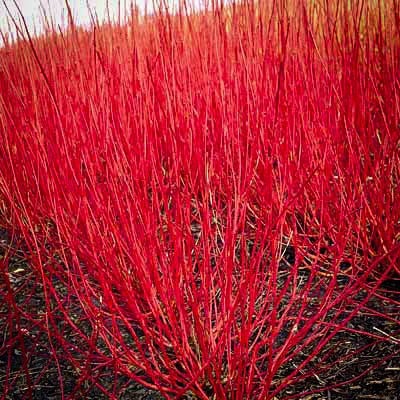

Red bark dogwoods are relatively fast-growing, low-maintenance shrubs. Regular trimming keeps the shrub’s twigs vibrant red from year to year. In winter, their spectacular red branches stand out against brown or gray leafless shrubs and trees. The hardy shrubs thrive in USDA zones 3 through 8. Red stem dogwood shrubs are ideal for adding bright colors to a drab winter garden. Dogwoods with red bark grow between 5 and 13 ft. These medium to tall deciduous shrubs are famous for colorful bark in various red shades - from bright lipstick red to deep burgundy red. The red twig dogwood plant is a group of flowering shrubs in the genus Cornus and the family Cornaceae. In the picture: Cornus sanguinea ‘Anny’s Winter Orange’

Red twig dogwood shrubs add beautiful color to your garden in winter. Additionally, there are helpful tips on successfully growing red twig dogwood shrubs in a garden landscape. Here you will find a guide to the most stunning dogwood shrubs with red twigs. Or maybe you want to grow beautiful flowering shrubs as a flowering hedge.


Suppose you want to add bright, colorful shrubs to a bare winter landscape. However, for more spectacular colors, there is the red osier dogwood ( Cornus sericea) with bright red twigs or the dogwood ‘Elegantissima’ with red branches and variegated leaves. The most common red twig dogwood is the red-barked dogwood ( Cornus alba) with burgundy-red branches. Several varieties of dogwood are classified as red twig dogwood shrubs. Red twigs brighten winter landscapes, and the white flowers contrast with lush green foliage in spring and summer months before turning spectacular orange and red colors in the fall. Red-stem dogwood shrubs provide gardens with four-season interest. Red twig dogwoods are spectacular bushes with bright red bark, beautiful white flowers, attractive green lance-shaped leaves, and white summer berries that persist until fall. The outstanding ornamental feature of this plant is its bright red winter stems.Email Pinterest Facebook Twitter Linkedin 'Cardinal' is a cultivar that is a rapid-growing, multi-stemmed, deciduous shrub which grows to a maximum size of 6-9' tall with a loose, rounded, spreading (stoloniferous) habit. Specific epithet from Latin means silky in reference to the hairs present on young twigs and upper leaf surfaces. Cornus is also the Latin name for cornelian cherry. Genus name comes from the Latin word cornu meaning horn in probable reference to the strength and density of the wood. Synonymous with and formerly known as Cornus stolonifera. Red stems somewhat resemble the reddish stems of some osier willows, hence the common name of red osier dogwood. Fruit is quite attractive to birds and is generally considered to have as much if not more ornamental interest than the flowers. Flowers give way to clusters of whitish (sometimes with a bluish tinge) drupes in summer. Tiny, fragrant, white flowers appear in flat-topped clusters (cymes to 2.5” diameter) in late spring, with sparse, intermittent, additional flowering sometimes continuing into summer. Reddish stems turn bright red in winter and are particularly showy against a snowy backdrop. Ovate to lanceolate, medium to dark green leaves (2-5” long) acquire interesting shades of red to orange eventually fading to purple in autumn. With the exception of the lower midwest and deep South, this species is native to much of North America where it is typically found growing in wet swampy areas, wetland margins or along lakes and rivers. Cornus sericea, commonly known as red twig dogwood or red osier dogwood, is an upright-spreading, suckering shrub that typically grows in the absence of pruning to 6-9’ tall with a slightly larger spread.


 0 kommentar(er)
0 kommentar(er)
